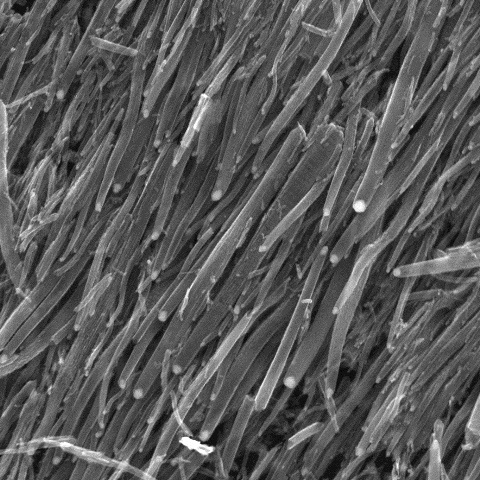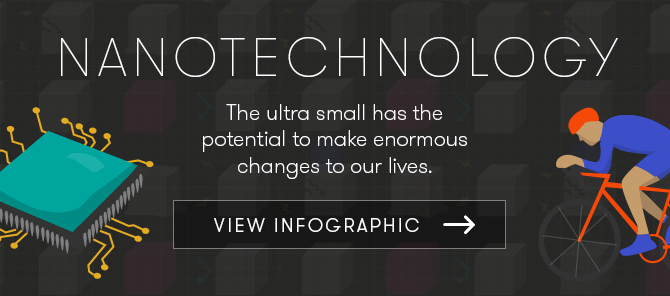Nanoscience: thinking big, working small
Expert reviewers
Professor Chennupati Jagadish FAA ATSE
Research School of Physics and Engineering
Australian National University
Essentials
- Nanoscience is the study of structures and materials on an ultra-small scale.
- A nanometre is one billionth of a metre.
- The physical and chemical properties of matter change at the nano level.
- Nanotechnology has the potential to revolutionise a diverse range of fields, from health care to manufacturing.
- The safety of nanomaterials and nanotechnology is still being debated, tested and assessed.
Nanoscience is an emerging area of science which involves the study of materials on an ultra-small scale and the novel properties that these materials demonstrate.
Nanoscience has the potential to reshape the world around us. It could lead to revolutionary breakthroughs in fields ranging from manufacturing to health care. But what is nanoscience, how does it work and how could it help change our lives?
Nanoscience vs nanotechnology
Before we continue we should clear something up. The terms nanoscience and nanotechnology are often used interchangeably, but they are in fact two very different things.
Nanoscience
Nanoscience is the study of structures and materials on an ultra-small scale, and the unique and interesting properties these materials demonstrate. Nanoscience is cross disciplinary, meaning scientists from a range of fields including chemistry, physics, biology, medicine, computing, materials science and engineering are studying it and using it to better understand our world.
Nanotechnology
Nanotechnology (also sometimes called molecular manufacturing), on the other hand, is the design, production and application of structures, devices and systems at the nanoscale. So essentially one is studying nanomaterials and their properties and the other is using those materials and properties to create something new or different. Got that? OK, let’s proceed.
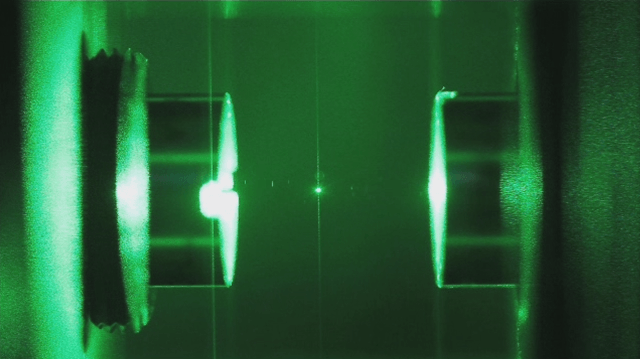 opener
opener
Glass nanoparticle suspended in optical cavity. Image source: James Millen (UCL Physics and Astronomy) / Flickr
The nanoscale
How small is nanoscale small?
The nanoscale is the dimensional range of approximately 1 to 100 nanometres. But what does this really mean?
Well, it’s so tiny that it might take a moment to get your head around—let’s go slowly. To begin, take a look at the back of your hand. Using just your eyes you can focus down to a scale of 1 centimetre to 1 millimetre. At this scale the skin looks flat. However, get out a magnifying glass and you can see it’s actually wrinkly with cracks and folds. The magnifying glass allows you to study the fine structure of the skin at less than a millimetre (or one-thousandth of a metre).
If you were to look more closely with a microscope you could examine the cells that make up your skin. Now you’re working at the scale of micrometres (one-thousandth of a millimetre), sometimes referred to as the microworld. Cells and bacteria are measured in micrometres, and electronic components on a silicon chip are usually around 1 micrometre in size.
To reach the nanoworld you have to go smaller again. A nanometre (nm) is 10-9, which is one-thousandth of a micrometre, or one-billionth of a metre. This is the scale at which we measure atoms and the molecules they make.
To give you some idea of the nanoscale, 10 hydrogen atoms laid side by side measure a nanometre across, a strand of DNA is 2.5 nm in diameter, while a red blood cell is about 7,000 nm wide. Need a few more examples? A human hair is between 50,000 and 100,000 nanometres thick, a single sheet of paper is around 75,000 nanometres thick, while a pinhead is around a million nanometres wide. If each person on Earth was the size of a nanometre, everyone on the planet would fit into one Hot Wheels matchbox car. So you get the idea—nano is super, super tiny.
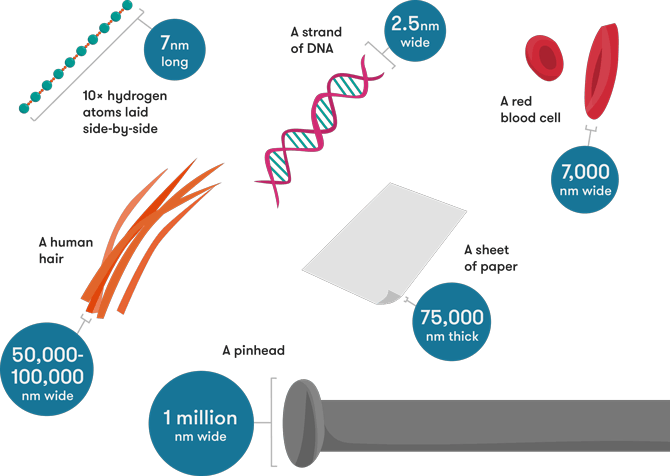
Seeing the nanoscale
While it might be right under our noses, the world of the ultra-small, in practical terms, is a distant place. It exists beyond any of our senses. So how do scientists see what’s going on in the nanoworld?
Ironically, to see the ultra-small we need big machines. As early as the 1930s scientists were able to see the nanoscale using instruments such as the scanning electron microscope (SEM), the transmission electron microscope (TEM) and the field ion microscope (FIM). These electron microscopes used a particle beam of electrons to illuminate a specimen and provided far greater resolution than traditional light microscopes. They could obtain magnifications up to one million times, whereas traditional light microscopes were limited to a magnification of around 1,500 times.
It’s only in the last three decades, however, that technology has given scientists the tools to really enable them to start working directly in this strange, small world. This technology heralded the beginning of nanotechnology. The most recent advancements in microscopy are the scanning tunnelling mircoscope (STM), the atomic force microscope (AFM) and holography, which allows us to see nanoscale materials in 3D.
Scanning tunnelling microscopes allow scientists to view three-dimensional images of objects at the atomic level, and to manipulate nanoscale particles, small molecules and atoms. A scanning tunnelling microscope can be used in air, water, ultra-high vacuum, and various other liquid or gas ambients, in temperatures ranging from near zero to a few hundred degrees Celsius. Atomic force microscopes obtain information about the nanoworld by ‘feeling’ the surface with a mechanical probe. They provide very high-resolution images, to distinguish a sample based on its mechanical properties (such as hardness or roughness), and can also undertake atomic manipulation.
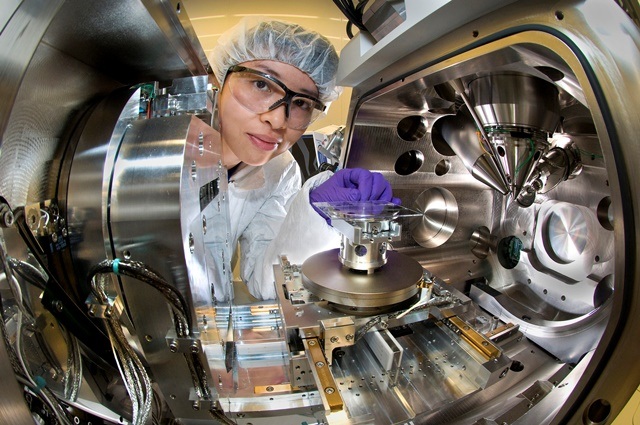 opener
opener
The Nanofabrication Facility at Brookhaven Center for Functional Nanomaterials. Image source: Brookhaven National Laboratory / Flickr.
Nanoscience changes things
One of the most exciting elements of operating in the nanoworld is that things behave differently when you go ultra-small. Essentially, the physical and chemical properties of matter change. Consider a lump of gold, yellowy in colour. If you were to break that lump into nanosized chunks, the gold would change colour depending on the size of the chunks. In the 10 to 100 nanometre range it can appear reddish (as well as orange, purple or green depending on the size or shape of the particle). Gold is also a catalyst when in this size regime but chemically inert at the micro/macro scale.
Indeed, by breaking down a ‘bulk’ material into nanosized particles you can often change many of its properties. By controlling the manner in which nanometre-scale molecular structures are formed, it is possible to control the fundamental properties of the materials these molecules build: properties such as colour, electrical conductivity, melting temperature, hardness, crack resistance and strength.
This is quite amazing when you consider that we are not changing the chemical composition or the crystal structure of the substance. We’re not adding a red pigment to the gold, just working with it in much smaller pieces. The physical and chemical properties change because we’re opening up and exposing more of the material’s surface area.
When particle sizes are reduced to the nanoscale, the ratio of surface area to volume increases dramatically. Since many important chemical reactions―including those involving catalysts―occur at surfaces, it is not too surprising that very small particles are staggeringly reactive. This is one of the reasons that chemists are very excited about nanoscience―if they can make more surface area, they can get more catalytic action, with the potential to speed up almost all physical and manufacturing processes, while increasing the resource and energy efficiency of those processes and products. Quantum properties also come into effect at nanoscale. Classical physics can’t explain why materials change colour when they change size—we need quantum mechanics GLOSSARY quantum mechanicsthe science of the very small; the body of scientific principles that explains the behaviour of matter and its interactions with energy on the scale of atoms and subatomic particles. to understand it.That is why nanoparticles are sometimes called as quantum dots GLOSSARY quantum dots(QD) are crystalline nanoparticles of semiconductor materials ranges from 2–10 nm in diameter. .
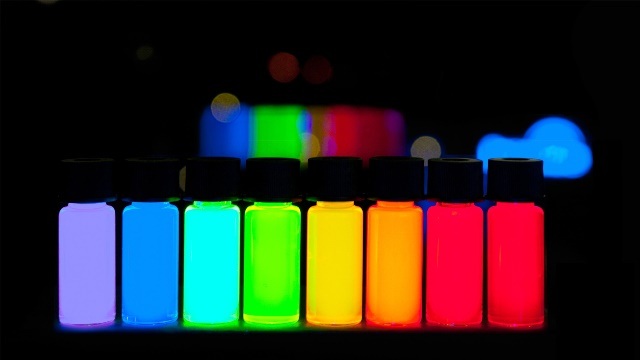 opener
opener
Quantum dots with vivid colours stretching from violet to deep red are being currently manufactured at PlasmaChem GmbH at a large scale. Image source: Antipoff / Wikimedia Commons.
What are nanomaterials?
The term ‘nanomaterials’ has a particular meaning. ‘Nanomaterials’ are materials at the nanoscale whose properties (such as conductivity, colour and mechanical hardness) change due to their nanoscale dimensions.
‘Nanomaterials’ encompass all nanoscale materials or materials that contain at least one nanoscale structure, either on their surfaces or internally. They can be inorganic, organic or biological. Nanomaterials such as nanoplates, nanoparticles, nanowires and nanotubes can be engineered in labs. Nanomaterials can also occur in nature—naturally occurring nanoparticles include smoke, sea spray and volcanic ash, as well as minerals, soils, salt particles and biogenic particles.
Nanoparticles, nanowires, nanotubes and nanoplates are all types of nanomaterials, distinguished by their individual shapes and dimensions. What these materials have in common is that they have one or more dimension at the nanoscale.
- Nanoparticles have all three dimensions within the nanoscale.
- Nanowires/tubes have diameters in the nanoscale, but can be several hundred nanometres long—or even longer.
- Nanoplates’ thickness is at the nanoscale, but their other two dimensions can be quite large. An example of a nanoplate is graphene, a sheet of carbon one atom thick.
Where to from here?
Decades of research and development in nanoscience and nanotechnology have delivered both expected and unexpected benefits for our society. Nanotechnology is helping to improve products across a range of areas, including food safety, medicine and health care, energy, transportation, communications, environmental protection and manufacturing. It is being used in the automotive, electronics and computing industries, and in household products, textiles, cosmetics—the list goes on. Already there are over 800 products on the market that are enhanced with nanotechnology.
The ability to tailor the core structures of materials at the nanoscale to achieve specific properties is at the heart of nanotechnology. A few examples of current nanotechnology include the following.
Food security
Nanosensors in packaging can detect salmonella and other contaminants in food.
Medicine
Some of the most exciting breakthroughs in nanotechnology are occurring in the medical field, allowing medicine to become more personalised, cheaper, safer and easier to deliver. The potential for nanotechnology to improve drug-delivery systems for a range of diseases including cancer, heart disease, diabetes and other age-related illnesses is an area of intense research for scientists. For example, a 2014 breakthrough saw the development of nano cages, which can theoretically deliver cancer-killing drugs directly at the molecular level.
This drug delivery method would reduce the dosage amount needed, target cancer cells rather than healthy cells, and reduce side effects. The technology is still being tested and undergoing approvals, but may see some real-world applications as early as 2016.
Other exciting developments include the possibility of using nanotechnology to increase the growth of nerve cells (for example in a damaged brain or spinal cord), and using nanofibres to help regenerate damaged spinal nerves (currently being tested on mice).
Energy
Nanotechnology is being used in a range of energy areas—to improve the efficiency and cost-effectiveness of solar panels, create new kinds of batteries, improve the efficiency of fuel production using better catalysis, and create better lighting systems.
Automotive
Nanoengineered materials are in a range of products including high-power rechargeable batteries, fuel additives, fuel cells and improved catalytic converters, which produce cleaner exhaust for longer periods.
Environment
Researchers are developing nanostructured filters that can remove virus cells and other impurities from water, which may ultimately help create clean, affordable and abundant drinking water.
A nanofabric paper towel, which can absorb 20 times its weight in oil, can be used for oil-spill clean-up operations.
Each development teaches us something about the technology, what it is capable of, and how we can refine it further. These developments are just the beginning.
Electronics
Many new screen-based appliances (TVs, phones, iPads and so on) incorporate nanostructured polymer films known as organic light-emitting diodes (OLEDs). These screens are brighter, lighter and have a better picture quality, among other things.
Textiles
Nanoscale additives in fabrics help resist staining, wrinkling and bacteria growth.
Cosmetics
Nanoscale materials in a range of cosmetics provide functions such as improved coverage, absorption or cleansing.
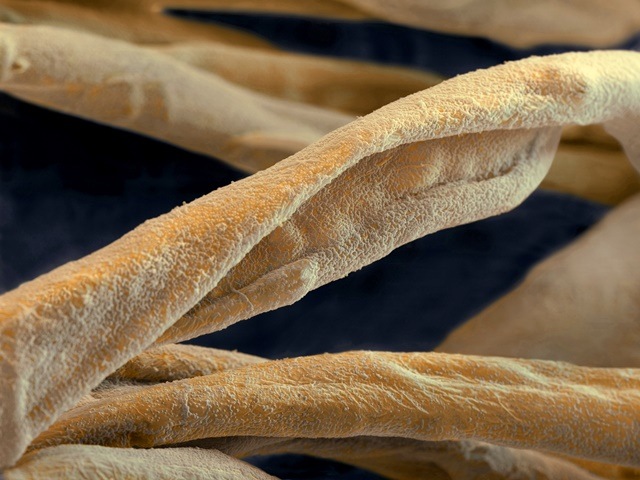
Concerns with nanotechnology
As with the spread of any powerful new technology, there are likely to be a range of negative as well as positive outcomes associated with nanotechnology.
As investment in nanoscience and nanotechnology continues, some people are voicing ethical, environmental and economic concerns. While science-fiction theories of ‘grey goo’ (millions of self-replicating nanomachines) with the potential to destroy the world are far fetched, there are valid concerns about other areas of nanoscience.
For example, how do manufactured nanoparticles interact with biological systems of the human body and what health effects may this have? In laboratory tests some nanomaterials have been shown to affect the formation of fibrous protein tangles, which are similar to those seen in some brain diseases. There is some evidence that nanoparticles could lead to genetic damage. Nanoparticles have also been examined for their impact on the heart and blood vessels.
Long-term exposure to nanoparticles, particularly as they become more common in everyday items, is something that needs to be monitored. Dr Sam Bruschi, toxicologist and member of the Nanotech Advisory Group of the National Industrial Chemicals Notification and Assessment Scheme (NICNAS) noted that carbon nanotubes, about 5,000 tonnes of which are produced each year for commercial use, have been shown to produce cancer in animal testing, and many resemble the shape and size of asbestos fibres.
The way that nanomaterials interact with the environment also needs further study. How a particle behaves in the lab may be very different to how it behaves in water, air or soil, and how it interacts with organic matter. Indeed, the way nanoparticles behave in the environment depends not only on their individual physical and chemical characters, but also on the character of the receiving environment (whether it is hot, wet, acidic and so on). When exposed to an environment, nanoparticles may remain intact, or undergo one of the following processes:
- dissolution GLOSSARY dissolutionthe act or process of resolving or dissolving into parts or elements
- speciation (association with other ionic or molecular dissolved chemical substances)
- settling
- agglomeration GLOSSARY agglomerationa mass or collection of things; an assemblage. / deagglomeration GLOSSARY deagglomerationThe process of breaking up or dispersing that which has agglomerated, or aggregated, or clustered together.
- biological or chemical transformation in to other chemicals.
Further research is needed in these areas and appropriate controls set up in relation to risk assessment.
There is also the possibility that nanomaterials may move from organism to organism, or through food chains. The fact that there are many different types of nanomaterials means there is the potential for a wide range of effects. Some experiments have shown that they could have harmful effects on invertebrates and fish, including changes to their behaviour, development and reproduction.
Risk assessment and testing needs to keep pace with the technology, especially as the use of nanomaterials expands into the production of ever more consumer goods. Testing needs to include methods for estimating exposure and identifying hazards. At present, the nanoparticles that possess the highest potential risk are free, insoluble nanoparticles, such as those dispersed in a dust or liquid.
As we have seen, the unique physical and chemical properties of nanomaterials also often differ from those of bulk materials and require special assessment. Despite these concerns, most scientists believe that nanoscience will lead to huge advances in medicine, biotechnology, manufacturing, information technology and other equally diverse areas.
 opener
opener
Nanoparticles occur naturally in the environment, but the impact of man-made nanomaterials on the environment is still unknown. Image source: Richard Rydge / Flickr.
Conclusion
Nanoscience is all about the ultra-small, but it has the potential to have an enormous impact on our lives. We are already using and enjoying many products enhanced with nanotechnology, but it is the potential to revolutionise fields such as medicine, or to help solve some of the world’s difficult environmental problems, that makes the future of nanoscience and nanotechnology most exciting.
However, nanotechnology—as with all new emerging technologies— is bringing up just as many problems as solutions. How can regulation and testing keep up with technology, and what impact might these new nanomaterials have on human health or the wider environment? These are issues that still need to be addressed. As greater investments continue to be made in nanotechnology and ever more nanoparticles find their way into our environment, products, and even bodies, it is vitally important that the potential benefits of this technology are carefully weighed and considered against the unknown risks.


